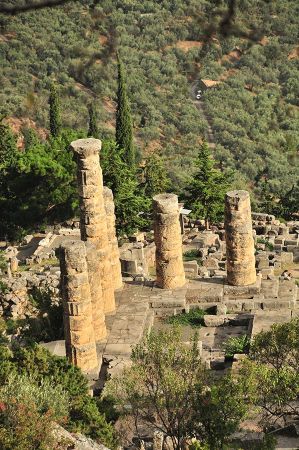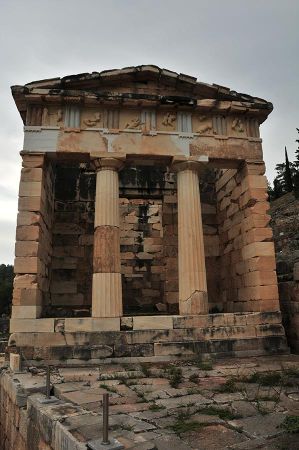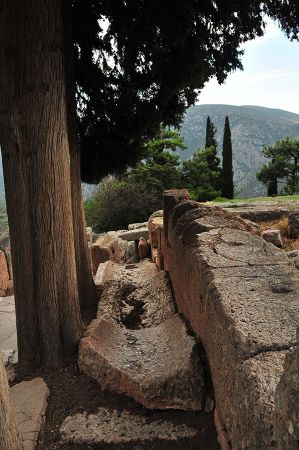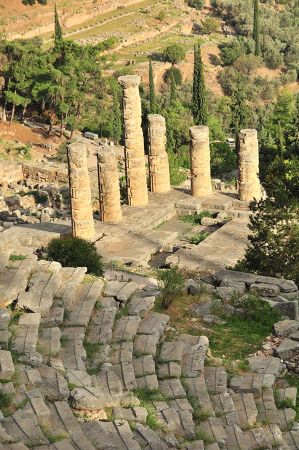Delphi - the sanctuary of Athena Pronaia
- Written by Portal Editor
The sanctuary of Athena Pronaia, the "Athena in front of the Temple", is situated on the other side of the Castilian gorge, a little further down and far below the site of the excavation.
It is this site, which is most important among the travelers of archeology as the actual cult of the Oracle of Delphi. The terrace used for the sanctuary of Athena Pronaia and modern "Marmaria" is 150 meters wide, but only 40 meters deep. All the buildings on it were oriented towards the south, towards the valley.
The path from the Marmaria to the Apollo sanctuary
 Under the oldest temple of the site were found more than 200 clay figures of a female deity, which was already revered to here in the second millennium BC. In the 8th or 7th century, this sacred area was first conceived with a neatly broken stone wall. The route from Marmaria to the sanctuary of the Apollo led past the well-known Kastal spring, from which, according to the ancient legend, drinking the water was helping to become a port.
Under the oldest temple of the site were found more than 200 clay figures of a female deity, which was already revered to here in the second millennium BC. In the 8th or 7th century, this sacred area was first conceived with a neatly broken stone wall. The route from Marmaria to the sanctuary of the Apollo led past the well-known Kastal spring, from which, according to the ancient legend, drinking the water was helping to become a port.
Toward the end of the 7th century BC a first Athena temple was erected, the remains of which were installed in the foundations of his successor. Thus it was a Peripteros Doric order, of which twelve capitals and ten column drums from Poros were found. The very slender columns, which were only about 3.10 meters high, had 16 mangles and carried wide, flat Doric capitals.
 The temple had existed for about 100 years before it was replaced by a new building towards the end of the 6th century BC and probably after the completion of the temple of the Alcmeonids. This second Athena Temple measured 13.25 x 27.46 meters in the Stylobat, and was thus proportioned in a 1: 2 scale and had 6 x 12 columns.
The temple had existed for about 100 years before it was replaced by a new building towards the end of the 6th century BC and probably after the completion of the temple of the Alcmeonids. This second Athena Temple measured 13.25 x 27.46 meters in the Stylobat, and was thus proportioned in a 1: 2 scale and had 6 x 12 columns.
In contrast to other Doric Peripteroi of his time, the building was devoid of an opisthodom, an otherwise normal backyard, which may be due to the cramped conditions on the terrace. The corresponding altar was on the eastern long side of the temple.
In the 4th century BC, the temple was heavily damaged by a rock fall, but remained as a ruin that could still be viewed by Pausanias. A new rockfall in 1905 caused 12 of the 15 columns that were still standing at this time to collapse and moved the entire foundation. As a result, the remaining pillars were also laid down.
 A third Athena temple was erected in a less threatened place in the west of the terrace, and a building with two cellae in this area was built. The temple, which dates from the late 4th century BC and was built in local limestone, was not a peripterus, but a prosthetic with a six-columned front, behind which the pronaos spread over the whole width.
A third Athena temple was erected in a less threatened place in the west of the terrace, and a building with two cellae in this area was built. The temple, which dates from the late 4th century BC and was built in local limestone, was not a peripterus, but a prosthetic with a six-columned front, behind which the pronaos spread over the whole width.
The cella did not convey a closed door wall, but two pillars connected to the walls and two half-pillars were constructed here, and the lateral openings were closed with grids, while the central opening took up a door. An exedra-like statues postament took up the back wall of the cella - probably afterwards installed - and was carried along the walls with short continuations into the room.
A Prostylos with a six-figure front
To the east of the third temple was the Tholos, a circular edifice designed by the architect Theodoros of Phokaia, about 380 BC, to which Theodorus also wrote a theoretical work called Vitruvius.
 The unusual round building, made entirely of pentelic marble, only the cellabode and the pedestal under the inner column position, were of dark, eleusinic limestone, and had a diameter of 13.50 meters in the stylobat. The diameter of the cylindrical structure of the cella was 8.60 meters. Twenty columns of Doric order, each with twenty capillaries, formed its peristasis.
The unusual round building, made entirely of pentelic marble, only the cellabode and the pedestal under the inner column position, were of dark, eleusinic limestone, and had a diameter of 13.50 meters in the stylobat. The diameter of the cylindrical structure of the cella was 8.60 meters. Twenty columns of Doric order, each with twenty capillaries, formed its peristasis.
They answered nine pillars of Corinthian order, a tenth column position was lost because of the opening of the door. Thus the Corinthian columns corresponded with every second intercolumnium of the peristasis in the radial-symmetrical design. Their columns, six meters high, bore a triglyphic metope frieze, of which forty metopes have been preserved only a few remnants with representations of centaurs and Amazons.
 Also the cella wall was crowned by a circulating triglyphon with 40 metopes. As a special feature the Tholos had a double Sima as a conclusion of the entablature. The building opened a small group of particularly valuable sanctuary buildings, all based on the principle of the round building and erected in the 4th century BC, with the Tholos of Epidauros and the Philippeion in Olympia, two other extraordinary representatives. The function of the Tholos in Delphi is unclear. Three of the 20 Doric columns were rebuilt in 1938.
Also the cella wall was crowned by a circulating triglyphon with 40 metopes. As a special feature the Tholos had a double Sima as a conclusion of the entablature. The building opened a small group of particularly valuable sanctuary buildings, all based on the principle of the round building and erected in the 4th century BC, with the Tholos of Epidauros and the Philippeion in Olympia, two other extraordinary representatives. The function of the Tholos in Delphi is unclear. Three of the 20 Doric columns were rebuilt in 1938.
In the Adyton, the most holy place of the temple, the Pythia sat on a tripod over a gorge, from which gaseous gases were discharged. The vapors put the Pythia in a state of trance, proclaiming the oracles of God, which were then transmitted by priests to the believing believers.
Please read as well:
Cultural Camper Trip through Albania - Macedonia - Greece
Delphi - from the theatre up to the stadium
-
 Delphi - the Oracle Temple Terrace
Delphi - the Oracle Temple Terrace
Delphi - the Oracle Temple Terrace
Delphi - the Oracle Temple Terrace
-
 Delphi - the Oracle Temple Terrace
Delphi - the Oracle Temple Terrace
Delphi - the Oracle Temple Terrace
Delphi - the Oracle Temple Terrace
-
 Delphi - the Oracle Temple Terrace
Delphi - the Oracle Temple Terrace
Delphi - the Oracle Temple Terrace
Delphi - the Oracle Temple Terrace
-
 Delphi - the Oracle Temple Terrace
Delphi - the Oracle Temple Terrace
Delphi - the Oracle Temple Terrace
Delphi - the Oracle Temple Terrace
-
 Delphi - the Oracle Temple Terrace
Delphi - the Oracle Temple Terrace
Delphi - the Oracle Temple Terrace
Delphi - the Oracle Temple Terrace
-
 Delphi - the Oracle Temple Terrace
Delphi - the Oracle Temple Terrace
Delphi - the Oracle Temple Terrace
Delphi - the Oracle Temple Terrace
-
 Delphi - the Oracle Temple Terrace
Delphi - the Oracle Temple Terrace
Delphi - the Oracle Temple Terrace
Delphi - the Oracle Temple Terrace
-
 Delphi - the Oracle Temple Terrace
Delphi - the Oracle Temple Terrace
Delphi - the Oracle Temple Terrace
Delphi - the Oracle Temple Terrace
-
 Delphi - the Oracle Temple Terrace
Delphi - the Oracle Temple Terrace
Delphi - the Oracle Temple Terrace
Delphi - the Oracle Temple Terrace
-
 Delphi - the Oracle Temple Terrace
Delphi - the Oracle Temple Terrace
Delphi - the Oracle Temple Terrace
Delphi - the Oracle Temple Terrace
-
 Delphi - the Oracle Temple Terrace
Delphi - the Oracle Temple Terrace
Delphi - the Oracle Temple Terrace
Delphi - the Oracle Temple Terrace
-
 Delphi - the Oracle Temple Terrace
Delphi - the Oracle Temple Terrace
Delphi - the Oracle Temple Terrace
Delphi - the Oracle Temple Terrace
-
 Delphi - the Oracle Temple Terrace
Delphi - the Oracle Temple Terrace
Delphi - the Oracle Temple Terrace
Delphi - the Oracle Temple Terrace
-
 Delphi - the Oracle Temple Terrace
Delphi - the Oracle Temple Terrace
Delphi - the Oracle Temple Terrace
Delphi - the Oracle Temple Terrace
-
 Delphi - the Oracle Temple Terrace
Delphi - the Oracle Temple Terrace
Delphi - the Oracle Temple Terrace
Delphi - the Oracle Temple Terrace
-
 Delphi - the Oracle Temple Terrace
Delphi - the Oracle Temple Terrace
Delphi - the Oracle Temple Terrace
Delphi - the Oracle Temple Terrace
-
 Delphi - the Oracle Temple Terrace
Delphi - the Oracle Temple Terrace
Delphi - the Oracle Temple Terrace
Delphi - the Oracle Temple Terrace
-
 Delphi - the Oracle Temple Terrace
Delphi - the Oracle Temple Terrace
Delphi - the Oracle Temple Terrace
Delphi - the Oracle Temple Terrace
-
 Delphi - the Oracle Temple Terrace
Delphi - the Oracle Temple Terrace
Delphi - the Oracle Temple Terrace
Delphi - the Oracle Temple Terrace
-
 Delphi - the Oracle Temple Terrace
Delphi - the Oracle Temple Terrace
Delphi - the Oracle Temple Terrace
Delphi - the Oracle Temple Terrace
-
 Delphi - the Oracle Temple Terrace
Delphi - the Oracle Temple Terrace
Delphi - the Oracle Temple Terrace
Delphi - the Oracle Temple Terrace
-
 Delphi - the Oracle Temple Terrace
Delphi - the Oracle Temple Terrace
Delphi - the Oracle Temple Terrace
Delphi - the Oracle Temple Terrace
-
 Delphi - the Oracle Temple Terrace
Delphi - the Oracle Temple Terrace
Delphi - the Oracle Temple Terrace
Delphi - the Oracle Temple Terrace
-
 Delphi - the Oracle Temple Terrace
Delphi - the Oracle Temple Terrace
Delphi - the Oracle Temple Terrace
Delphi - the Oracle Temple Terrace
-
 Delphi - the Oracle Temple Terrace
Delphi - the Oracle Temple Terrace
Delphi - the Oracle Temple Terrace
Delphi - the Oracle Temple Terrace
-
 Delphi - the Oracle Temple Terrace
Delphi - the Oracle Temple Terrace
Delphi - the Oracle Temple Terrace
Delphi - the Oracle Temple Terrace
-
 Delphi - the Oracle Temple Terrace
Delphi - the Oracle Temple Terrace
Delphi - the Oracle Temple Terrace
Delphi - the Oracle Temple Terrace
https://www.alaturka.info/en/greece/delphi/3679-delphi-the-sanctuary-of-athena-pronaia#sigProId16ef648bed
